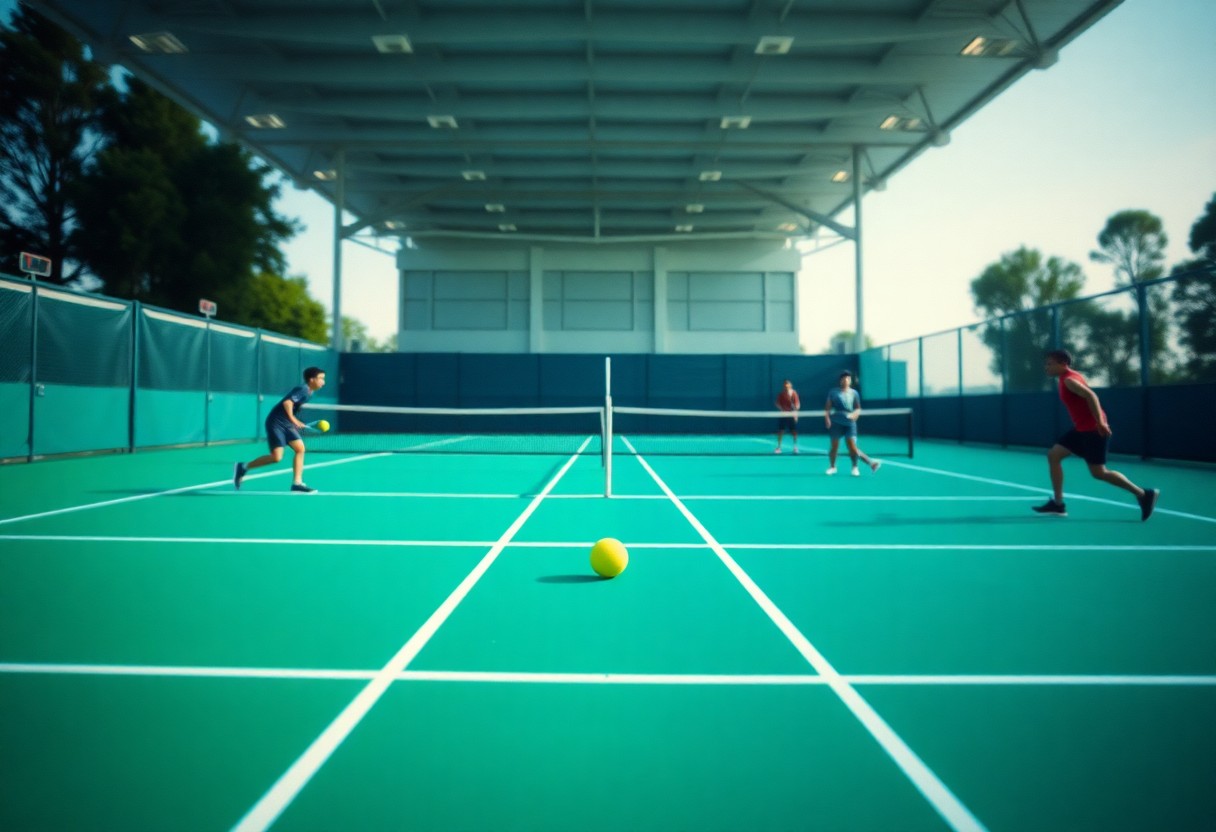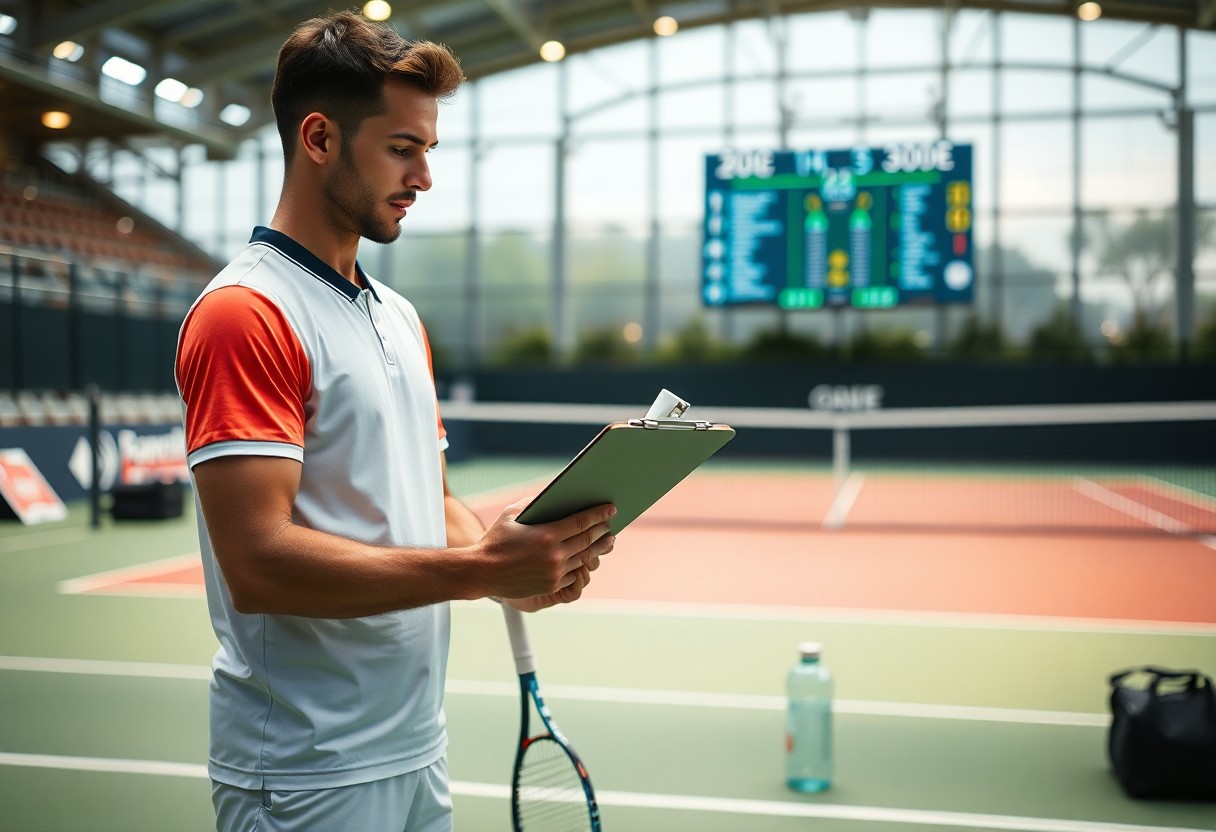Doubles play offers a unique set of strategic advantages and challenges that differ significantly from singles. Understanding these key distinctions can elevate your game, whether you’re aiming for precision shots in singles or effective teamwork in doubles. This guide examines into the tactical variations every tennis player should master to enhance their performance and adapt their style accordingly. Equip yourself with the insights necessary for success on both fronts.
Types of Tennis Matches
- Singles: Matches between two players, focusing on individual skills and stamina.
- Doubles: Matches featuring two teams of two, emphasizing teamwork and communication.
- Mixed Doubles: A combination of male and female players on each team, promoting gender balance and strategy.
- League Matches: Competitive matches within a specific organization, testing player skills at various levels.
- Exhibition Matches: Non-competitive matches often showcasing top players in a more entertaining, less formal context.
Knowing the differences helps players choose appropriate strategies for their matches.
| Singles | One player competes against another, requiring high individual skill and endurance. |
| Doubles | Two players work with one another against an opposing pair, enhancing strategic plays. |
| Mixed Doubles | Teams combine both genders, demanding adaptation and collaboration. |
| League Matches | Structured matches within tennis organizations, promoting competition. |
| Exhibition Matches | Casual, entertaining matches often featuring professional players. |
Singles
In singles, one player battles another, compelling each athlete to showcase their technical skills, endurance, and mental toughness over the duration of the match. The court is completely theirs to command, allowing for an expansive range of tactics, whether through aggressive baseline play or subtle net approaches. Serving and returning become even more pivotal as players rely solely on their own abilities to outmaneuver their opponent.
Doubles
Doubles tennis alters the dynamics significantly, as players rely on teamwork and coordination. With four participants on the court, strategies pivot around covering more ground, fostering quick reflexes, and executing synchronized plays. The necessity for communication becomes imperative; effective verbal and non-verbal signals can enhance court coverage and shot selection, often leading to effectively executed volleys and strategic positioning.
Doubles matches not only demand individual skill but also a thorough understanding of partner dynamics and communication tactics. Players must anticipate each other’s movements and intentions, fostering synergy that can define match outcomes. This type of play often emphasizes net play and quick exchanges, making agility and reaction time vital. Through practice, teams can develop plays that leverage their styles, ensuring they capitalize on each partner’s strengths while compensating for weaknesses.
Strategic Factors to Consider
Both singles and doubles formats require different strategic approaches. Players must evaluate their strengths and weaknesses, assess opponents’ tactics, and apply specific strategies accordingly. Key factors include:
- Court Positioning
- Shot Selection
- Psychological Tactics
- Communication
Recognizing these considerations can significantly affect performance outcomes.
Court Coverage
In singles, players cover the entire court, making it crucial to have excellent footwork and stamina. Anticipating the opponent’s shots is vital, as any lapse can lead to quick points against. Doubles players, however, can strategically position themselves to guard specific zones, allowing for specialization in areas like net play and coverage. This synergy is pivotal in controlling the match flow.
Team Dynamics
In doubles matches, team dynamics become a fundamental aspect of strategy. Successful partnerships rely on understanding each player’s strengths, weaknesses, and playing styles. Effective communication is paramount; calling shots and coordinating movements can create opportunities and prevent confusion. Players often benefit from practicing together to establish a seamless rhythm, which is critical during high-pressure moments.
In more advanced scenarios, analyzing opponents to identify their weaknesses contributes to team performance. Establishing roles within the partnership strengthens execution—for instance, one player may specialize in powerful serves while the other excels at volleying. Such defined roles, coupled with synchronized movements, can create formidable pairings that dominate the court.
Playing Styles and Techniques
Singles Strategy
In singles, players must develop a well-rounded skill set, emphasizing powerful serves and accurate groundstrokes to control points. Players often rely on a mix of power and spin to create opportunities for winners, while also mastering footwork to position themselves effectively. Court coverage is key, as players need to anticipate their opponent’s moves and respond quickly, often engaging in rallies that test endurance and mental focus.
Doubles Strategy
Doubles play prioritizes teamwork and court positioning, with players relying on each other to cover angles and create openings. Effective communication becomes important for success, as partners coordinate their shots and positioning to dominate the net. The use of overlapping roles allows players to capitalize on strengths, ensuring the team maintains offensive pressure and limits opponent’s options.
In doubles strategy, establishing control of the net is paramount. Players should aim to serve and volley effectively, allowing them to pressure opponents immediately. Additionally, the formation of a “I-formation” can confuse returning teams, enhancing the element of surprise. Teams must also adapt to the pace of play, utilizing quick exchanges and strategic placements to exploit weaknesses. Mastering these techniques can turn the tide of a match, transforming defensive plays into powerful attacks.
Pros and Cons of Singles
| Pros | Cons |
|---|---|
| Enhances individual skills | Higher physical demand |
| Develops mental toughness | Less social interaction |
| Complete control over strategy | Increased pressure to perform |
| Opportunity for personal achievement | Requires extensive stamina |
| Fewer players involved | Longer match durations |
Advantages
Playing singles provides several advantages, primarily the opportunity to improve individual skills and tactical awareness. Players can focus solely on their technique and decision-making, leading to significant enhancement in areas such as serving, returning, and court coverage. Moreover, singles matches cultivate mental resilience, as players absorb pressure and rely on their own abilities to clinch victory.
Disadvantages
Despite its benefits, singles tennis presents notable downsides. The physical demands are heightened compared to doubles, resulting in increased fatigue during matches. This can lead to a higher risk of injury, particularly for those lacking stamina. Furthermore, players bear the entire responsibility for match outcomes, which can create significant psychological pressure.
The greater physical demand in singles is evident as players cover a larger portion of the court with each point. Intense rallies can take a toll on stamina, forcing players to maintain peak performance for longer periods. In contrast to doubles, where teamwork facilitates points, singles requires players to consistently outmaneuver their opponent alone, escalating the strain both physically and mentally. Consequently, players must be well-conditioned to endure matches that can frequently extend beyond two hours, raising the stakes for endurance and strategic play.
Pros and Cons of Doubles
| Pros | Cons |
|---|---|
| Enhanced teamwork and communication | Less focus on individual skills |
| Opportunities for strategic gameplay | Greater reliance on partner’s performance |
| Lower physical strain on individual players | Complex court positioning |
| Higher chances of winning with a reliable partner | Mismatch in skill levels can be detrimental |
| Variety in playing styles | Less emphasis on shot variety |
Advantages
Playing doubles fosters teamwork and communication, enhancing the overall experience. It allows players to share the physical and mental workload, reducing individual strain. With two players strategizing together, partners can develop unique plays that exploit opponents’ weaknesses. Additionally, doubles matches often lead to longer rallies, promoting exciting exchanges and enhancing tactical awareness.
Disadvantages
While doubles can be enjoyable, it often results in a diminished focus on individual skill development. Players may find reliance on partners challenging, especially if one partner underperforms. The court dynamics in doubles lead to a need for exceptional communication and positioning, which can overwhelm those who favor solo play. Notably, players may struggle to showcase their unique playing style due to the interdependent nature of the game.
This dependence on a partner can create significant stress, especially in high-stakes situations where inconsistent performance emerges. If one player lacks the necessary skills, the entire team’s chances of success are severely impacted, leading to frustration and hindering personal growth. Additionally, newcomers may find it difficult to navigate the complexities of doubles positioning, which can detract from their enjoyment and learning experiences.
Tips for Improving Performance
To elevate your tennis game, focusing on specific techniques and strategies can yield significant improvements. Analyze your performance through video reviews, work on your fitness with agility drills, and engage in consistent practice. Additionally, adopting a proper mental approach can help manage pressure during matches. Utilize these strategies effectively to enhance your overall performance. Any dedicated player can benefit from such targeted efforts.
Singles Tips
In singles, honing your footwork and court coverage is vital for success. Prioritize developing a strong serve and solid baseline play to dominate rallies. Training with a focus on your mental strength is equally important, as matches often hinge on psychological resilience. Any player can improve their singles performance by focusing on these aspects.
Doubles Tips
Doubles matches require a different focus, emphasizing teamwork and communication with your partner. Work on developing your net play and practice volleying skills to close out points efficiently. Understanding court positioning and practicing strategic serves can also enhance your effectiveness on the court. This insight into gameplay is critical for winning in doubles.
Effective doubles play hinges on both individual and partner skills. Establish clear signals for communication and develop a strong understanding of court coverage responsibilities. Practicing together can improve your team chemistry, allowing for smoother exchanges and better coverage of the court. Prioritize strategic formations to maximize your chances of success. This collaborative approach is vital for mastering doubles matches.
Step-by-Step Guide to Transitioning Between Formats
| Steps | Details |
|---|---|
| Assessing Skill Level | Evaluate your abilities in both singles and doubles to identify which skills need enhancement. |
| Adjusting Strategy | Adapt your gameplay approach based on whether you’re playing singles or doubles. |
Assessing Skill Level
Evaluating your current skill level is vital for a smooth transition between singles and doubles. Take stock of your strengths, such as shot accuracy and serving techniques, while also identifying weaknesses like court coverage and volleying. Understanding your skill profile allows for a targeted improvement plan tailored to the format you’re stepping into.
Adjusting Strategy
Strategic adjustments are fundamental when transitioning between singles and doubles. In singles, focus on exploiting your opponent’s weaknesses through a wider range of shots. Conversely, in doubles, position your shots to set up your partner effectively. Additionally, communication becomes pivotal in doubles, emphasizing the need for clear signals and coordinated movements to dominate the net.
While transitioning, consider the court dynamics; in singles, you cover the entire court yourself, enhancing stamina and shot placement. In doubles, you must capitalize on your partner’s positioning, making quick decisions based on a shorter reaction time. Adjusting strategies could also involve drills that focus on net play for doubles and baseline consistency for singles, ensuring you are well-rounded in both formats.
FAQ
Q: What are the main strategic differences between singles and doubles play in tennis?
A: In singles, players must cover the entire court, focusing on positioning and accuracy for consistent shots. In doubles, players rely on teamwork, positioning themselves to cover the net and create angles. Communication is key in doubles, while in singles, individual skills dominate the strategy.
Q: How does the serving strategy differ in singles compared to doubles?
A: In singles, players often serve with the aim to overpower their opponent and create opportunities for follow-up shots. In doubles, the serve is often used to position teammates at the net, and serves may focus on placement rather than power to exploit gaps between opponents.
Q: What are effective positioning tactics for each format in tennis?
A: In singles, maintaining a strong baseline position is vital for responding to various shots. Players utilize angles and depth to control play. In doubles, positioning is more dynamic; at least one player should be at the net to intercept volleys, while the other covers the baseline to handle deep shots.




